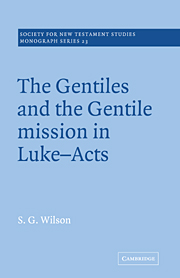Book contents
- Frontmatter
- Contents
- Abbreviations
- Preface
- 1 Jesus and the Gentiles
- 2 The Gentiles in Luke's Gospel
- 3 Lukan eschatology
- 4 The early chapters of Acts
- 5 Stephen and the Hellenists
- 6 Paul's conversion
- 7 Cornelius and the Apostolic Council
- 8 Paul's speech on the Areopagus
- 9 Jewish and Gentile missions
- 10 Summary and conclusions
- Bibliography
- Index of passages
- Index of authors
- Index of subjects
9 - Jewish and Gentile missions
Published online by Cambridge University Press: 04 March 2010
- Frontmatter
- Contents
- Abbreviations
- Preface
- 1 Jesus and the Gentiles
- 2 The Gentiles in Luke's Gospel
- 3 Lukan eschatology
- 4 The early chapters of Acts
- 5 Stephen and the Hellenists
- 6 Paul's conversion
- 7 Cornelius and the Apostolic Council
- 8 Paul's speech on the Areopagus
- 9 Jewish and Gentile missions
- 10 Summary and conclusions
- Bibliography
- Index of passages
- Index of authors
- Index of subjects
Summary
In this section we shall look in detail at a number of passages: Acts 2: 39, 3: 25–6, 13: 46–7, 15: 14–17, 18: 6, 28: 26–8. In all of these the problem of the relationship between the Jewish and Gentile missions is raised. At this stage we are concerned in particular with Luke's view, although a comparison with Paul at a later stage will attempt to show how near to or far from the historical facts Luke is. In dealing with these programmatic statements in Acts, in particular 28: 26–8, we shall also need to discuss the various theories concerning the ending of Acts.
PROGRAMMATIC STATEMENTS
Acts 2: 39
The phrase πᾶσιν τοĩς εἰς μακράν is ambiguous: it could refer to the Gentiles, but in the context of Acts 2 probably refers to the Jews. εἰς μακράν is best understood spatially (cf. Acts 22: 21; Is. 57: 19; Sir. 24: 32), as a reference to Diaspora Jews contemporary with those being addressed, rather than as a reference to the future descendants of Peter's audience.
Acts 3: 25–6
This is one of the most important verses for understanding Luke's view of the relationship between the Jewish and Gentile missions; unfortunately, its exact meaning is obscure.
- Type
- Chapter
- Information
- The Gentiles and the Gentile Mission in Luke-Acts , pp. 219 - 238Publisher: Cambridge University PressPrint publication year: 1973
- 2
- Cited by



